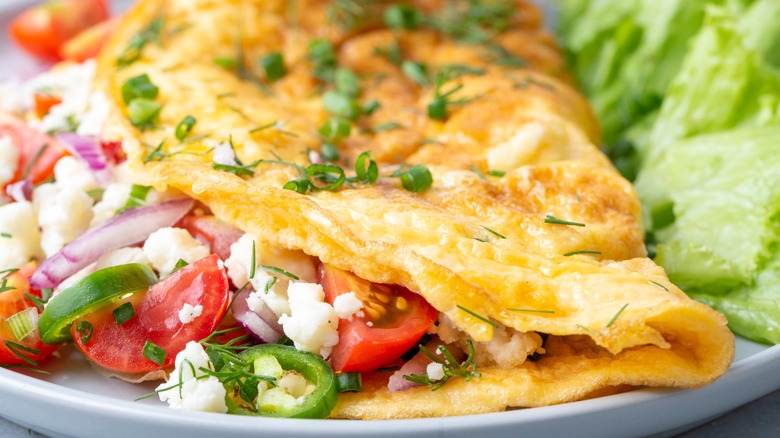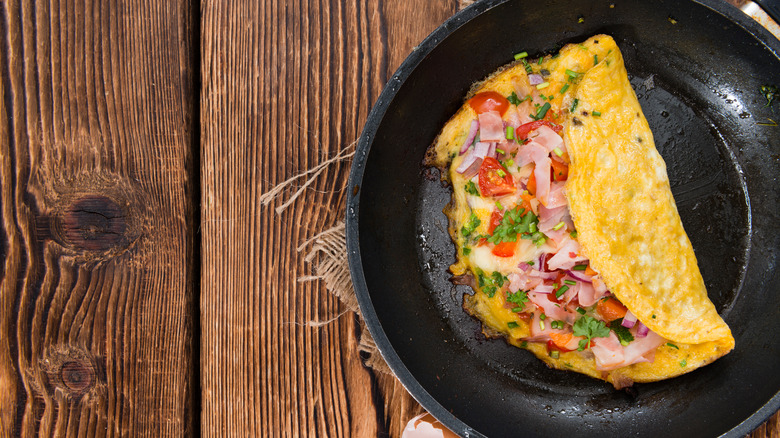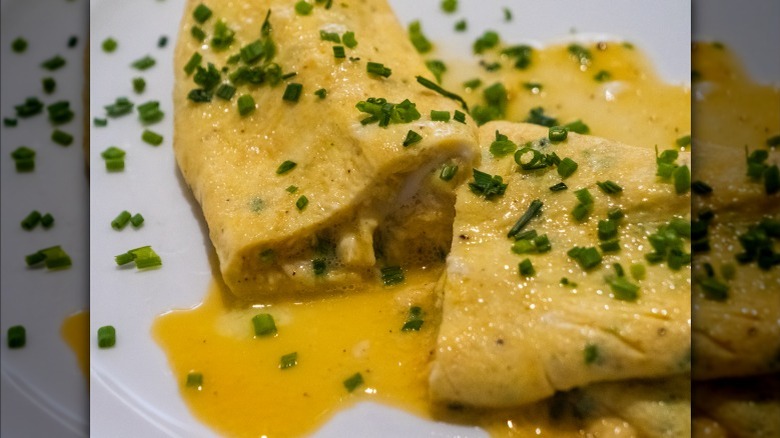Here Are The Differences Between American And French Omelets
Eggs are an important part of various cuisines all around the world. There's carbonara from Italy, a Scotch egg from the United Kingdom, egg drop soup from China, huevos rancheros from Mexico, to name a few, per CNN. A good reason why eggs are so popular is that they are extremely versatile and a great source of protein, healthy fats, and vitamins, according to Healthline. Interestingly, the average American ate about 288 eggs each in 2022 (via Statista), and the country that's the top producer of eggs in the world is China, with 596.5 billion eggs being produced by the country in 2020, per Statista.
There are seven basic ways to prepare eggs: boiled, poached, fried, scrambled, baked, microwaved, and in an omelet. In a survey from 2019 by YouGovAmerica, it was found that a majority of Americans like their eggs best scrambled. Over easy was the second most favored egg cooking style, with sunny-side up eggs coming in third place. One way to cook eggs that may often get overlooked is an omelet, and there is actually more than one way to make them. For example, there's an American omelet and a French omelet, and their differences are notable.
American omelets often have fillings and are cooked longer
An American omelet is something that most of us should be familiar with, Americans especially, and it starts the same way as a French omelet, according to Chef's Vision. Both omelet techniques begin with whisking eggs together in a bowl, and that's about the only step in which they are similar. For an American omelet, you'll then add any fillings you'd like to a preheated pan with butter and start sauteing them. French omelets aren't typically made with fillings, but if they are, then fillings are light instead of heavy like American omelets. Fillings for American omelets can include cheese such as cheddar, vegetables such as onion, meat such as ham, and herbs such as parsley.
Once the fillings for the American omelet are cooked you can add the scrambled eggs to the pan, making sure the egg covers the entire surface area of the pan and the fillings. Some American omelets have their fillings added after the egg is completely cooked, per Southern Living. After the American omelet's underside is crispy and lightly browned, half of it is folded over to make a semicircle shape, and it's ready to enjoy. American omelets are also often cooked at higher temperatures than French omelets.
French omelets are cooked quickly
The technique for French omelets is sometimes difficult to properly execute, but it can be achieved and perfected with enough practice. For French omelets, the pan used is extremely important, and nonstick pans or pans made of cast iron will be the best vessel for the job, per MasterClass. Once you whisk your eggs in a bowl, add them to a pan that's been preheated on medium-low heat. Mix the eggs together quickly with a spatula and keep moving them around until there's not as much runny egg to move around anymore. When that happens, turn off the heat and roll the omelet by tilting the pan away from yourself. Before finishing the entire roll, you can add a few fillings if you'd like to the center of the omelet, according to Southern Living. However, French omelets are typically not made with fillings, and the fillings that are used tend to be lighter such as cheese and herbs.
The end result should be a French omelet that's somewhat runny and moist on the inside and light and smooth on the outside. So, instead of being a golden semicircle like an American omelet, a French omelet will look lighter in color, be rolled up, and may be considered underdone to people who have only had American omelets. French omelets should also be served with the "seam" of the omelet facing the plate and topped with melted butter for a clean presentation.


